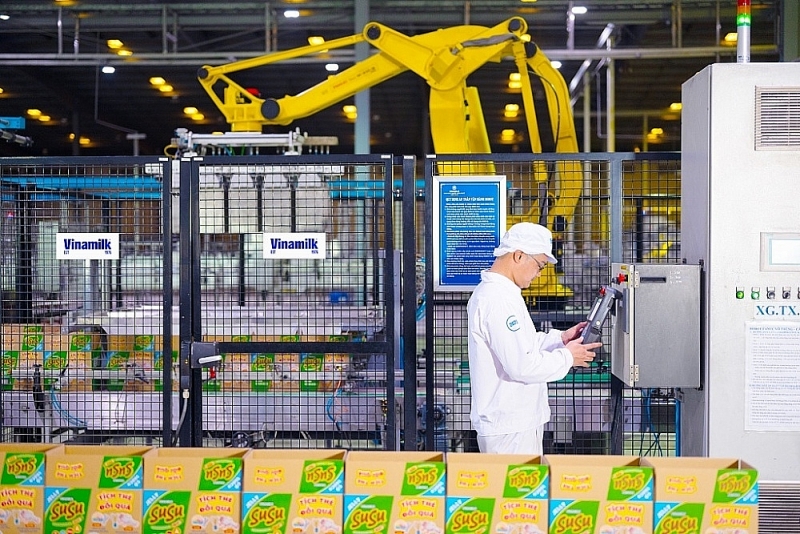Building the Vietnamese brand associated with green and sustainable development
According to experts, in the current context, branding becomes even more urgent, helping to increase endogenous resources for businesses, helping businesses move towards strong development, gradually reaching further in the domestic and world markets.
 |
|
Vinamilk, one of the sustainable brands, maintains green brand development. Photo: provided by enterprise |
Brand "soft internal force" for business development
Sharing the story around building Vietnamese product brands, especially in the current green trade context, Mr. Nguyen Anh Duc, Chairman of the Vietnam Retailers Association, General Director of the Union of Trading Cooperatives Ho Chi Minh City said that currently, in the domestic market, Vietnamese goods had made positive changes and achieved many remarkable results. Vietnamese goods were also gradually moving in a very strong "green" direction; At the same time, take advantage of new opportunities, typically free trade agreements. Consumers had access to a wide variety of high-quality domestic goods, with 75%-85% of goods on supermarket shelves being Vietnamese products. Vietnamese goods also overcame difficulties and gradually conquerred the world market with competitive quality and prices.
Statistics from the Central Institute for Economic Management Research shows that, with an export value of creative goods reaching US$ 14,153 million, Vietnam has risen to the Top 10 exporting countries in the world. With the internal development of each business, along with advantages from many new generation Free Trade Agreements, it has created impressive economic growth for many years, contributing to bringing Vietnam into the group of 20 the world's leading trading countries.
However, besides the above positive bright spots, there is still a very sad reality that has been going on for many years. That is, most Vietnamese products, especially agricultural products, are having to "borrow brands" for export.
Research by NielsenIQ Vietnam shows that up to 77% of customers make shopping decisions based on brand. Customers who love a brand create an emotional attachment that leads to higher loyalty, increase profits, and positive word-of-mouth advertising for the businesses. About 43% of customers spend more money on products from brands they are loyal to. Therefore, investing in brands is to directly or indirectly increase the internal production and competitiveness of Vietnamese businesses and Vietnamese goods in both domestic and foreign markets. This is also building "soft internal resources" for Vietnamese businesses.
Green - a new element for the brand
In the current green trade context, branding becomes even more urgent.
Associate Professor Dr. Nguyen Hong Quan, Director of the Institute for Circular Economy Research and Development, Ho Chi Minh City National University, said that circular economy was the future of the global economy. The future was circular, green or there is no future. However, the circular economy must be linked to the market to encourage businesses to participate.
According to Mr. Nguyen Ngoc Hoa, Chairman of Ho Chi Minh City Business Association, it was necessary to find new elements for Vietnamese products, creating new features to help Vietnamese brands go further. The new factor is the green factor. Recently, the Bangladesh textile industry succeeded in building the "green textile" brand, bringing in many orders. This was a very thoughtful story. It can be seen that the greening process required great determination and perseverance from businesses, especially business leaders. Therefore, it needed a green forest - an entire Vietnamese business community working together, not just a few individual businesses.
From business reality, Ms. Vo Thi Lien Huong, General Director of Secoin Joint Stock Company shared that the Secoin patterned tile brand was highly appreciated for its artistic, historical and cultural value, currently present in many countries in the world. In particular, Secoin was striving to have a brick factory achieving international green certification this year. Distributors of this brand in Europe were very supportive and said that the certificate would be a passport for Secoin around the world. Countries were also willing to pay higher prices for products that meet green standards.
However, according to Ms. Lien Huong: "When we go international, they don't know that we are Secoin, they only know that we are Vietnamese products, and care about whether Vietnamese products are good or not. We alone cannot tell the story of Vietnam. We need to add many other brands to create synergy of Vietnamese products, so that “when the tide rises, all boats rise'”.
Mr. Vuong Ngoc Dung, Marketing Director, Saigon Cosmetics Joint Stock Company (SCC) said that in order to meet the standards of the international market, SCC's direction was to work closely with foreign partners right from the beginning, so that exported products would immediately meet the standards. SCC's orientation was to penetrate difficult markets such as Japan and was researching the Indian market. According to Mr. Dung, despite 50 years of ups and downs, SCC still retained its own identity, but the company could not go alone when entering large and difficult markets. “We need partners to create greater strength. Our company needs great support from authorities, the Government as well as support policies for Vietnamese brands to conquer foreign markets”, Mr. Vuong Ngoc Dung affirmed.
| Statistics from the Ministry of Industry and Trade clearly show that up to 70-80% of Vietnam's goods are crude exports with low added value. There are currently many countries importing Vietnamese goods in raw form, or investing in agricultural product processing factories in Vietnam, then pre-processing, mixing, and packaging under the manufacturer's brand. Then sell it on the market at a price dozens of times higher. |








